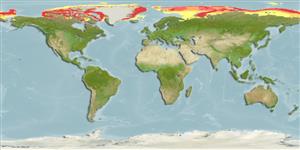>
Gadiformes (Cods) >
Gadidae (Cods and haddocks)
Etymology: Arctogadus: Greek, arktos = narrow + Latin , gadus = a fish (cod?) (Ref. 45335).
More on author: Peters.
Environment: milieu / climate zone / depth range / distribution range
Ecología
marino batipelágico; no migratorio; rango de profundidad 0 - 1000 m (Ref. 1371). Deep-water; 87°N - 65°N, 130°W - 161°W (Ref. 1371)
Arctic and Northeast Atlantic: widely distributed in western part of Arctic basin, also northwest and northeast coasts of Greenland.
Tamaño / Peso / Age
Maturity: Lm ? range ? - ? cm
Max length : 32.5 cm TL macho / no sexado; (Ref. 1371)
Espinas dorsales (total) : 0; Espinas anales: 0. Chin barbels rudimentary or absent.
Associated with ice (cryopelagic or epontic), found mainly in offshore waters, at or beyond the edge of the continental shelf (Ref. 1371). Feeds on fishes and crustaceans (Ref. 58426). Of little economic value (Ref. 1371).
Life cycle and mating behavior
Madurez | Reproducción | Puesta | Huevos | Fecundidad | Larva
Oviparous, sexes are separate (Ref. 101194).
Cohen, D.M., T. Inada, T. Iwamoto and N. Scialabba, 1990. FAO species catalogue. Vol. 10. Gadiform fishes of the world (Order Gadiformes). An annotated and illustrated catalogue of cods, hakes, grenadiers and other gadiform fishes known to date. FAO Fish. Synop. 125(10). Rome: FAO. 442 p. (Ref. 1371)
IUCN Red List Status (Ref. 130435: Version 2024-1)
Threat to humans
Harmless
Human uses
Pesquerías: escaso valor comercial
Herramientas
Special reports
Download XML
Fuentes de Internet
Estimates based on models
Preferred temperature (Ref.
123201): -1.3 - 1.6, mean -0.1 °C (based on 2624 cells).
Phylogenetic diversity index (Ref.
82804): PD
50 = 1.0000 [Uniqueness, from 0.5 = low to 2.0 = high].
Bayesian length-weight: a=0.00794 (0.00424 - 0.01487), b=3.10 (2.94 - 3.26), in cm total length, based on LWR estimates for this (Sub)family-body shape (Ref.
93245).
Nivel trófico (Ref.
69278): 3.2 ±0.35 se; based on food items.
Resiliencia (Ref.
120179): Medio, población duplicada en un tiempo mínimo de 1.4-4.4 años (Preliminary K or Fecundity.).
Fishing Vulnerability (Ref.
59153): Low vulnerability (23 of 100).
Nutrients (Ref.
124155): Calcium = 39.2 [12.8, 104.3] mg/100g; Iron = 0.432 [0.174, 1.267] mg/100g; Protein = 17.6 [15.8, 19.4] %; Omega3 = 0.197 [0.076, 0.500] g/100g; Selenium = 14.6 [4.9, 40.4] μg/100g; VitaminA = 33.6 [4.1, 260.5] μg/100g; Zinc = 0.587 [0.320, 1.167] mg/100g (wet weight);
